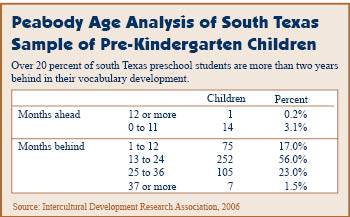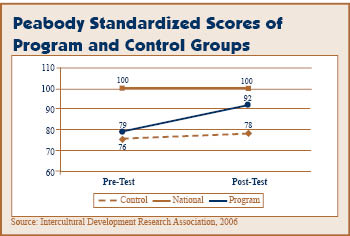• by Felix Montes, Ph.D. • IDRA Newsletter • September 2006 • 
Many 3 and 4 year-old low-income and minority children appear to have the academic linguistic development of 1 and 2 year-old children, according to preliminary results of an IDRA study. Such results seem to set up children for educational failure from the start. But increased support for education at the preschool level can make a huge difference. This article will begin to show the dimension of this issue and outlines what can be done to alleviate it.
Need for Quality Preschool
IDRA recently assessed a sample of 454 preschool students in south Texas and found that the vast majority are significantly behind in their school vocabulary development and very likely will not be academically ready to enter school when they turn 5 years old or even 6 years old, unless an appropriate intervention is implemented.
The Peabody Picture Vocabulary Test yielded a standardized mean score for these children of 76.6, which is significantly below the national norm (100). Peabody provides evidence of children’s language development through its age equivalent analysis (Williams and Wang, 1997). The table in below summarizes what the analysis revealed.
As the table shows, 80 percent of the children are more than one year behind in their vocabulary development, and one out of every four children is at least two years behind. Over 20 percent are more than two years behind!
Considering that these are 3- and 4-year-old children, this is an alarming finding. And it only corroborates similar previous assertions in the field. In a recent article, Dr. Klein states, “Depending on what is being assessed, anywhere from 25 percent to 60 percent of our young children are not ready to be successful when they begin kindergarten” (2004).
This is particularly alarming because there is a clear link between children leaving school and their low academic development.
Again, Dr. Klein adds, “Of the children who drop out of high school, half were behind before they even entered a kindergarten classroom” (2004).
Magnuson, et al., state, “Children from economically disadvantaged families enter school with fewer academic skills than their more advantaged peers (although not with less enthusiasm for learning), and substantial gaps in cognitive and academic competencies persist in later school years” (2004).
The National Institute for Early Childhood Research has systematically documented this in its recent report, “The State of Preschool: 2003 State Preschool Yearbook. It says: “State preschool programs are failing the nation’s children. Few set high standards and fewer still provide adequate funding. Even the disadvantaged children targeted by most state preschool initiatives are not assured of access to high-quality programs. Most children and their families receive even less help. Children’s learning and development suffers as a result. This must change” (Barnett, et al., 2003).
For each state, the report provides indicators for preschool access, quality standards and resources provided. For example, the report indicates that Texas meets only two of the 10 benchmarks in the quality standards checklist (Barnett, et al., 2003).
Preschool Reforms Net Results
The good news is that this can be changed. With funding from the U.S. Department of Education, IDRA is implementing a research study that examines the effects of professional development models on the effectiveness of Head Start teachers to teach early literacy skills of 3- and 4-year-old minority and low-income children. After a year of operation, we compared program children’s outcomes with other children not participating in the program on a pre-test and post-test basis, using the Peabody. The chart below shows the resulting values.
The chart shows that the program children have improved their language development from a 79 standardized score to 92, while the children not receiving the benefits of the program have essentially remained at the same pre-test value. The Peabody is a standardized assessment with a national mean of 100 and standard deviation of 15.
Although program children have improved and approached the national mean, they have not yet achieved it, underscoring the need for additional improvements. At the same time, the improvement to date should be considered nothing short of spectacular.
These children scored 1.5 standard deviations below the norm before the program was implemented. After only one year of participating in the program, children moved one full standard deviation toward the norm, so that they now stand half a standard deviation below the norm. Quite an achievement.
Creating Centers of Excellence
How was this accomplished? The major goal of IDRA’s Reading Early for Academic Development (READ) project is to establish in participating preschool centers classrooms of excellence that collectively form a center of excellence that ensures reading, cognitive and emotional success for all preschool children through a print-rich environment. The project uses a classroom-based professional development approach that enables teachers to form an integrated instructional program that eventually prevents Head Start children from encountering reading difficulties when they enter school.
These centers of excellence are dynamic and have, at their core, students who are acquiring basic skills and competencies in oral language development, phonological awareness, alphabet knowledge and print awareness. Classrooms of excellence are vibrant, active, engaging, interactive learning spaces where children are supported to achieve reading competency with a teacher who guides and facilitates the process. Teachers encourage communication and language exploration through discussions in both the English and Spanish languages as a basis for learning English.
All of this is achieved by an interconnected professional development plan. IDRA trainers provide an enhanced version of HeadsUp! Reading that integrates research-based principles and practices for providing children with a strong foundation in early reading and writing. The training consists of instruction delivered live, via the HeadsUp! Satellite Network. In order to serve the majority of the project’s students and families, who are Hispanic, IDRA enhanced HeadsUp! Reading, through addressing the early literacy needs of native Spanish-speaking students and their families.
Another vital component consists of classroom-based professional development sessions, including practical application sessions and classroom demonstration. Teachers are continuously supported by daily coaching and mentoring.
In the end, all of those components come together to create a learning community in each center. Teachers meet to discuss topics of interest, and IDRA’s training staff provide information related to these topics and organize the discussions.
As IDRA’s READ project’s promising results suggest, with appropriate training and support, preschool centers can become centers of excellent education to prepare all children to succeed in school.


Resources
Barnett, W.S., and K.B. Robin, J.T. Hustedt, K.L. Schulman, The State of Preschool: 2003 State Preschool Yearbook (New Brunswick, N.J.: National Institute for Early Education Research, 2003).
Klein, L.G. “The Current State of Early Childhood Education,” The Evaluation Exchange (Cambridge, Mass.: Harvard Family Research Project, 2004).
Magnuson, K.A., and M.K. Meyers, C.J. Ruhm, J. Waldfogel. “Inequality in Preschool Education and School Readiness,” American Education Research Journal (2004) 41(1), 115-157.
Williams, K.T., and J. Wang. Technical References to the Peabody Picture Vocabulary Test – Third Edition (PPVT-III) (Circle Pines, Minn.: AGS, 1997).
Felix Montes, Ph.D., is an education associate in the IDRA Division of Professional Development. Comments and questions may be directed to him via e-mail at feedback@idra.org
[©2006, IDRA. This article originally appeared in the September 2006 IDRA Newsletter by the Intercultural Development Research Association. Permission to reproduce this article is granted provided the article is reprinted in its entirety and proper credit is given to IDRA and the author.]



